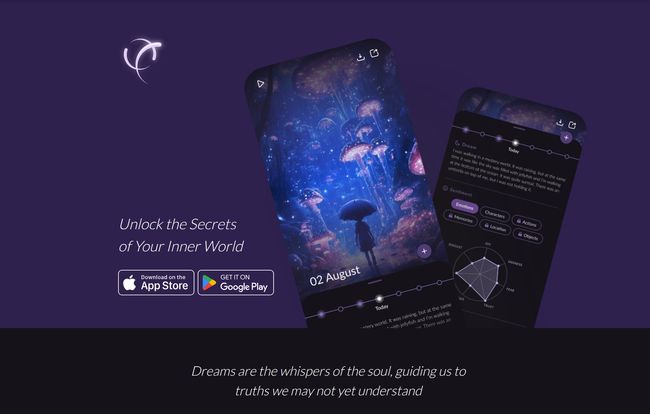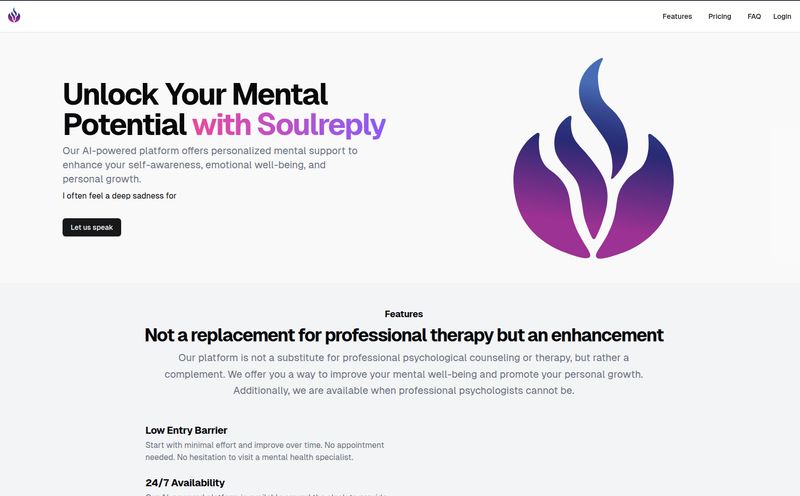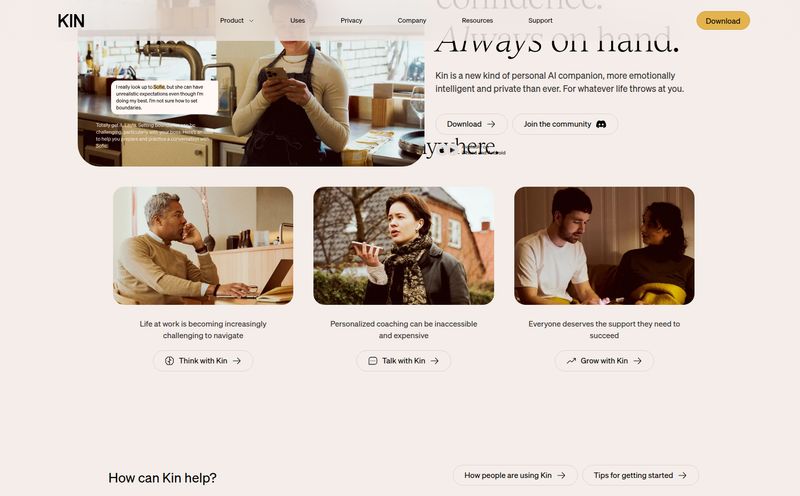I had the weirdest dream last night. I was trying to explain CPC inflation to a group of penguins on a floating iceberg, but they were more interested in the fish-flavored SEO reports I was holding. I woke up thinking... what on earth was that about?
We all have them. Those bizarre, vivid, or just plain confusing dreams that stick with us long after the alarm clock goes off. For centuries, we’ve turned to everything from ancient texts to Freudian psychoanalysis to figure them out. Now, in an age where AI is writing our emails and creating our art, it was only a matter of time before it came for our dreams. And that’s where an app called Dreamseer enters the chat.
As someone who spends their days knee-deep in analytics and digital trends, I'm naturally skeptical of anything that claims to decode something as messy and human as the subconscious. But I'm also incredibly curious. So, I downloaded Dreamseer to see if it’s genuinely a new tool for self-discovery or just another techy gimmick.
What Exactly is Dreamseer?
Okay, let's get the basics out of the way. Dreamseer isn't just a digital diary where you type out your nocturnal adventures. It pitches itself as a platform that uses a blend of data science, AI, and art to help you map out your inner world. Think of it as a smart dream journal. You log your dreams, and its AI-powered assistant helps you spot patterns, understand symbols, and connect the dots between your dream life and your waking one.
The first thing that caught my eye wasn't the tech, but the team. The landing page lists a surprisingly academic crew: a PhD in psychiatry, a dream researcher, a philosopher, alongside the expected software devs and UX pros. This isn't your typical startup vibe. It suggests a more thoughtful foundation, which, I'll admit, lowered my skepticism a few notches. They seem to be building a bridge between hard science and the ephemeral nature of dreams.

Visit Dreamseer
My First Impressions and Getting Started
Downloading and opening the app is a smooth experience. The interface is all cool, calming purples and blues—it feels like a space designed for introspection, not for getting you hyped up. The "Good morning, Seer" greeting is a nice touch. It feels personal.
But the real game-changer for me? The voice-to-text dream logging. Let’s be real, nobody wants to fumble for their phone in the dark, squinting at a bright screen and trying to type with sleepy thumbs. Being able to just... talk... and have the dream captured is brilliant. It makes the act of recording a dream feel much more natural and immediate, which is crucial for remembering those fleeting details.
The Core Features That Stand Out
After using it for a while, a few features really started to shine. It's not just one thing, but how they work together.
The AI Interpretation Engine
This is the heart of Dreamseer. After you log a dream, the AI gets to work. It’s not like those old-school dream dictionaries that tell you "teeth falling out means anxiety." It's a bit more nuanced. The AI acts as a guide, asking questions and suggesting potential meanings for symbols within the context of your dream. It felt less like a vending machine spitting out answers and more like a brainstorming partner. The app also has something called the Dreampedia, which is basically an interactive encyclopedia for common dream symbols. It's a fantastic resource for when you want to go a little deeper on your own.
More Than a Diary – The Dream Journal and Personal Analysis
This is where Dreamseer moves beyond being a simple novelty. The app compiles your entries into Emotional Insights and even Monthly Reports. It’s one thing to analyze a single dream about penguins; it’s another to see a report showing that you dream about icebergs every time a big project deadline looms. It’s like a fitness tracker for your psyche. It helps you see the bigger picture and reveals patterns you would absolutely miss otherwise. I started seeing connections between stressful work weeks and specific recurring dream themes. A little unsettling? Yes. Incredibly useful? Also yes.
The 'Dreamverse' Community Aspect
Now this part might not be for everyone. Dreamseer has a feature that allows users to share their dream experiences anonymously. The idea is to build a "collective Dreamverse." My first thought was, "Do I really want to share my weird penguin dream with strangers?" But the more I thought about it, the more interesting it became. Seeing that other people also have absurd anxiety dreams makes your own feel a little less isolating. It fosters a strange sense of shared human experience, which I didnt expect.
The People Behind the Curtain
I have to come back to the team, because in the world of fly-by-night apps, this is a huge differentiator. You have Elmira, with a PhD in psychiatry. Aidan, a dedicated dream researcher. Michaela, a PhD student in philosophy. This academic grounding gives the platform a weight that most competitors lack. It tells me they're concerned not just with user acquisition but with the psychological and ethical implications of their work. They're not just trying to build a cool product; they're trying to build a responsible one. That earns a lot of trust in my book.
So, What’s the Catch? A Few Things to Consider
No tool is perfect, and Dreamseer is no exception. It’s important to go in with the right expectations.
- It's a tool, not a therapist. This is critical. The AI insights are fascinating, but they are interpretations generated by an algorithm. It's a platform for self-reflection, not a substitute for professional mental health support. Over-relying on it could lead you down some strange rabbit holes.
- The gamified feel might vary. Being called a "Seer" and exploring a "Dreamverse" is fun, but if you're looking for a purely clinical, no-frills tool, this might not be your cup of tea.
- What's the price? At the time of this review, I couldn’t find a clear pricing page on their main site. Like most apps of its kind, you’ll find the pricing details on the App Store or Google Play page. It likely operates on a freemium model, with a free version for basic journaling and a subscription for the advanced AI analysis and reports.
Who Is Dreamseer Really For?
So, who should download this? If you’re the kind of person who is curious about your inner life, enjoys journaling, or is interested in psychology and self-discovery, I think you’ll get a lot out of Dreamseer. It’s for the introspective, the curious, and anyone who’s ever woken up and just thought, “what was that all about?”
If you're seeking treatment for a serious mental health condition, however, please stick to qualified human professionals. Think of Dreamseer as a fascinating supplement, not a replacement.
In the end, my initial skepticism has mostly melted away. Dreamseer is a beautifully designed, thoughtfully constructed tool that surprised me with its depth. It doesn't claim to have all the answers, but it gives you a powerful new lens through which to find your own. It’s a compelling peek into how technology can help us understand the most ancient and mysterious part of ourselves. For this data-driven SEO, it’s a welcome and surprisingly insightful journey into the qualitative chaos of the human mind.
Frequently Asked Questions about Dreamseer
- Is Dreamseer a replacement for therapy?
- Absolutely not. The app itself is clear on this. It is a tool for self-discovery and personal insight, not a medical or therapeutic device. If you are struggling with your mental health, please consult a qualified healthcare professional.
- How does the AI dream interpretation work?
- While the exact algorithm is proprietary, it likely uses advanced Natural Language Processing (NLP) and machine learning. It's trained on a massive dataset of psychological research, dream symbolism, and mythological archetypes to identify themes, symbols, and emotional tones in your text and connect them to established psychological frameworks.
- Is my dream data private?
- The platform emphasizes a "Privacy First!" approach. Dream sharing in the community is anonymous. However, as with any app, it is always a good idea to read their full privacy policy to understand exactly how your data is stored and used.
- What is the Dreampedia feature?
- The Dreampedia is a built-in, searchable library of common dream symbols and their potential meanings. Unlike a static dictionary, it's integrated into the app's analysis, providing context for the symbols that appear in your specific dreams.
- Is Dreamseer free?
- Dreamseer likely operates on a freemium model. This typically means there's a free version with basic features like dream journaling, and a paid subscription that provides access to premium features like the in-depth AI analysis, monthly reports, and full access to the Dreampedia. Check the App Store or Google Play for the most current pricing.
Reference and Sources
- Official Website: While the exact URL can vary, information was gathered from the official Dreamseer landing page (likely accessible via a domain like dreamseer.com or dreamseer.ai).
- Further Reading on AI in Mental Health: For those interested in the broader context, articles from publications like Psychology Today or WIRED often discuss the intersection of AI and psychology, providing a great backdrop for understanding tools like Dreamseer.



